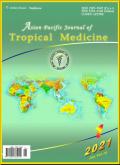Faunal richness and checklist of sandflies (Diptera: Psychodidae) in India
IF 1.6
4区 医学
Q3 PUBLIC, ENVIRONMENTAL & OCCUPATIONAL HEALTH
引用次数: 0
Abstract
This review aims to fill the voids and to update the checklist of sandfly fauna along with its spatial distribution in India. Resource databases i.e. either online or offline were searched to deduce the information to systematize the Indian sandfly fauna. Articles/data retrieved were screened and analysed to further update the available latest checklist. The species name and authorship were given in accord with the International Code for Zoological Nomenclature. We compiled an updated checklist of reported Indian sandfly species along with their state-wise distribution till 2022 as per published literature. Kerala has maximum number of species reports when compared to other endemic states and states with pockets of transmission. Phlebotomus argentipes is the most widely distributed, recorded so far, followed by other Sergentomiya and Phlebotomus species in India. In this review, we have also described the vector and non-vector species of sandfly prevalent in different parts of the country. Phlebotoiella eoindianensis, an amber fossil sandfly species recorded from Gujarat might be older than other records of Indian sandfly fauna. So far 69 species (4 genera and 15 subgenera/groups) of Phlebotomine sandflies have been recorded in India. Proper knowledge of species diversity and its distribution is a prerequisite for planning a systematic vector control strategy and disease management.印度沙蝇的区系丰富度和清单(直翅目:Psychodidae)
本次审查旨在填补空白,并更新沙蝇动物及其在印度的空间分布清单。搜索资源数据库,即在线或离线,以推断信息,使印度沙蝇动物群系统化。对检索到的文章/数据进行筛选和分析,以进一步更新可用的最新检查表。该物种的名称和作者身份符合《国际动物命名规范》。根据已发表的文献,我们编制了一份最新的印度沙蝇物种清单,以及截至2022年的各州分布情况。与其他流行州和有传播区的州相比,喀拉拉邦的物种报告数量最多。阿根廷白鳍豚是迄今为止分布最广的物种,其次是印度的其他Sergentomiya和白鳍豚。在这篇综述中,我们还描述了在该国不同地区流行的沙蝇媒介和非媒介物种。Phlebotoella eoindianensis,一种记录于古吉拉特邦的琥珀色沙蝇化石物种,可能比印度沙蝇动物群的其他记录更古老。到目前为止,印度已记录到69种(4属,15亚属/群)白粉蝶。适当了解物种多样性及其分布是规划系统病媒控制战略和疾病管理的先决条件。
本文章由计算机程序翻译,如有差异,请以英文原文为准。
求助全文
约1分钟内获得全文
求助全文
来源期刊

Asian Pacific journal of tropical medicine
PUBLIC, ENVIRONMENTAL & OCCUPATIONAL HEALTH-TROPICAL MEDICINE
CiteScore
4.00
自引率
9.70%
发文量
1936
审稿时长
3-8 weeks
期刊介绍:
Asian Pacific Journal of Tropical Medicine (ISSN 1995-7645 CODEN: APJTB6), a publication of Editorial office of Hainan Medical University,is a peer-reviewed print + online Monthly journal. The journal''s full text is available online at http://www.apjtm.org/. The journal allows free access (Open Access) to its contents and permits authors to self-archive final accepted version of the articles on any OAI-compliant institutional / subject-based repository.
APJTM aims to provide an academic communicating platform for international physicians, medical scientists, allied health scientists and public health workers, especially those of the Asia-Pacific region and worldwide on tropical medicine, infectious diseases and public health, and to meet the growing challenges of understanding, preventing and controlling the dramatic global emergence and re-emergence of infectious diseases in the Asia-Pacific.
The journal is proud to have an international and diverse editorial board that will assist and facilitate the publication of articles that reflect a global view on tropical medicine, infectious diseases and public health, as well as emphasizing our focus on supporting the needs of public health practitioners. The APJTM will allow us to seek opportunities to work with others who share our aim, and to enhance our work through partnership, and to uphold the standards of our profession and contribute to its advancement.
 求助内容:
求助内容: 应助结果提醒方式:
应助结果提醒方式:


